
Aachen Cathedral is a Roman Catholic church in Aachen, Germany and the seat of the Roman Catholic Diocese of Aachen.
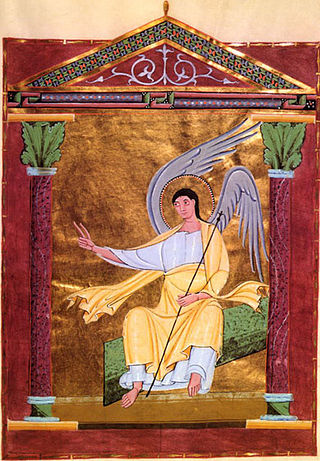
The Pericopes of Henry II is a luxurious medieval illuminated manuscript made for Henry II, the last Ottonian Holy Roman Emperor, made c. 1002–1012 AD. The manuscript, which is lavishly illuminated, is a product of the Liuthar circle of illuminators, who were working in the Benedictine Abbey of Reichenau, which housed a scriptorium and artists' workshop that has a claim to having been the largest and artistically most influential in Europe during the late 10th and early 11th centuries. An unrivalled series of liturgical manuscripts was produced at Reichenau under the highest patronage of Ottonian society.

A tetramorph is a symbolic arrangement of four differing elements, or the combination of four disparate elements in one unit. The term is derived from the Greek tetra, meaning four, and morph, shape.
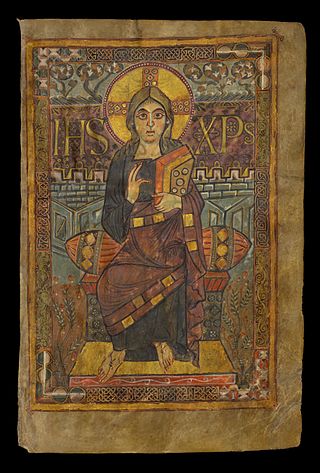
The Godescalc Evangelistary, Godescalc Sacramentary, Godescalc Gospels, or Godescalc Gospel Lectionary is an illuminated manuscript in Latin made by the Frankish scribe Godescalc and today kept in the Bibliothèque nationale de France. It was commissioned by the Carolingian king Charlemagne and his wife Hildegard on October 7, 781 and completed on April 30, 783. The Evangelistary is the earliest known manuscript produced at the scriptorium in Charlemagne's Court School in Aachen. The manuscript was intended to commemorate Charlemagne's march to Italy, his meeting with Pope Adrian I, and the baptism of his son Pepin. The crediting of the work to Godescalc and the details of Charlemagne's march are contained in the manuscript's dedication poem.

Carolingian art comes from the Frankish Empire in the period of roughly 120 years from about 780 to 900—during the reign of Charlemagne and his immediate heirs—popularly known as the Carolingian Renaissance. The art was produced by and for the court circle and a group of important monasteries under Imperial patronage; survivals from outside this charmed circle show a considerable drop in quality of workmanship and sophistication of design. The art was produced in several centres in what are now France, Germany, Austria, northern Italy and the Low Countries, and received considerable influence, via continental mission centres, from the Insular art of the British Isles, as well as a number of Byzantine artists who appear to have been resident in Carolingian centres.

Ottonian art is a style in pre-romanesque German art, covering also some works from the Low Countries, northern Italy and eastern France. It was named by the art historian Hubert Janitschek after the Ottonian dynasty which ruled Germany and northern Italy between 919 and 1024 under the kings Henry I, Otto I, Otto II, Otto III and Henry II. With Ottonian architecture, it is a key component of the Ottonian Renaissance. However, the style neither began nor ended to neatly coincide with the rule of the dynasty. It emerged some decades into their rule and persisted past the Ottonian emperors into the reigns of the early Salian dynasty, which lacks an artistic "style label" of its own. In the traditional scheme of art history, Ottonian art follows Carolingian art and precedes Romanesque art, though the transitions at both ends of the period are gradual rather than sudden. Like the former and unlike the latter, it was very largely a style restricted to a few of the small cities of the period, and important monasteries, as well as the court circles of the emperor and his leading vassals.

The Ottonian Renaissance was a renaissance of Byzantine and Late Antique art in Central and Southern Europe that accompanied the reigns of the first three Holy Roman Emperors of the Ottonian dynasty: Otto I (936–973), Otto II (973–983), and Otto III (983–1002), and which in large part depended upon their patronage. The leading figures in this movement were Pope Sylvester II and Abbo of Fleury.

The Vienna Coronation Gospels, also known simply as the Coronation Gospels, is a late 8th century illuminated Gospel Book produced at the court of Charlemagne in Aachen. It was used by the future emperor at his coronation on Christmas Day 800, when he placed three fingers of his right hand on the first page of the Gospel of Saint John and took his oath. Traditionally, it is considered to be the same manuscript that was found in the tomb of Charlemagne when it was opened in the year 1000 by Emperor Otto III. The Coronation Evangeliar cover was created by Hans von Reutlingen, c. 1500. The Coronation Evangeliar is part of the Imperial Treasury (Schatzkammer) in the Hofburg Palace in Vienna, Austria.

Christ in Majesty or Christ in Glory is the Western Christian image of Christ seated on a throne as ruler of the world, always seen frontally in the centre of the composition, and often flanked by other sacred figures, whose membership changes over time and according to the context. The image develops from Early Christian art, as a depiction of the Heavenly throne as described in 1 Enoch, Daniel 7, and The Apocalypse of John. In the Byzantine world, the image developed slightly differently into the half-length Christ Pantocrator, "Christ, Ruler of All", a usually unaccompanied figure, and the Deesis, where a full-length enthroned Christ is entreated by Mary and St. John the Baptist, and often other figures. In the West, the evolving composition remains very consistent within each period until the Renaissance, and then remains important until the end of the Baroque, in which the image is ordinarily transported to the sky.

The Gospels of Otto III is considered a superb example of Ottonian art because of the scope, planning, and execution of the work. The book has 276 parchment pages and has twelve canon tables, a double page portrait of Otto III, portraits of the four evangelists, and 29 full page miniatures illustrating scenes from the New Testament. The cover is the original, with a tenth-century carved Byzantine ivory inlay representing the Dormition of the Virgin. Produced at the monastery at Reichenau Abbey in about 1000 CE., the manuscript is an example of the highest quality work that was produced over 150 years at the monastery.
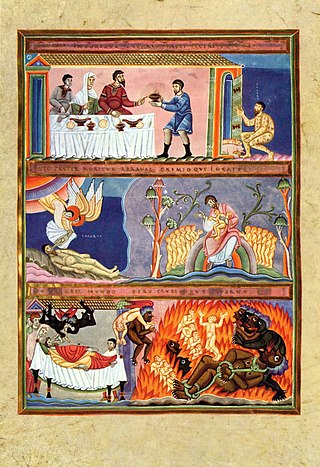
The Codex Aureus of Echternach is an illuminated Gospel Book, created in the approximate period 1030–1050, with a re-used front cover from around the 980s. It is now in the Germanisches Nationalmuseum in Nuremberg.
The Proserpina sarcophagus is a Roman marble sarcophagus from the first quarter of the third century AD, in which Charlemagne was probably interred on 28 January 814 in Aachen cathedral. It is displayed today in the Aachen Cathedral Treasury.

The Aachen Altar or Passion Altar (Passionsaltar) is a late gothic passion triptych in the Aachen Cathedral Treasury, made by the so-called Master of the Aachen Altar around 1515/20 in Cologne.
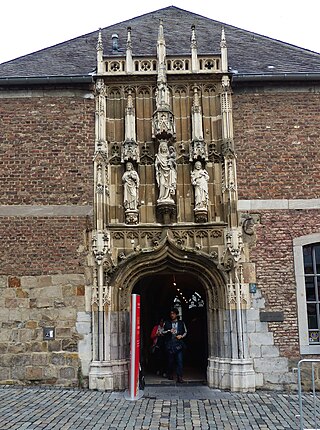
The Aachen Cathedral Treasury is a museum of the Roman Catholic Diocese of Aachen under the control of the cathedral chapter, which houses one of the most important collections of medieval church artworks in Europe. In 1978, the Aachen Cathedral Treasury, along with Aachen Cathedral, was the first monument on German soil to be entered in the List of UNESCO World Heritage Sites. The treasury contains works from Late Antique, Carolingian, Ottonian, Staufen, and Gothic times. The exhibits are displayed in premises connected to the cathedral cloisters.
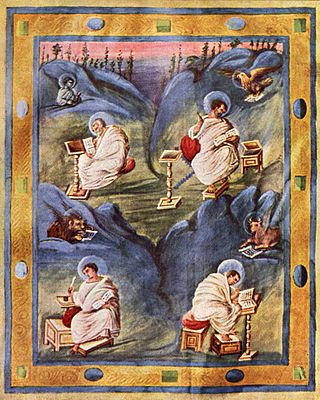
The Aachen Gospels are a Carolingian illuminated manuscript which was created at the beginning of the ninth century by a member of the Ada School. The Evangeliary belongs to a manuscript group which is referred to as the Ada Group or Group of the Vienna Coronation Gospels. It is part of the church treasury of Charlemagne's Palatine Chapel, now Aachen Cathedral, and is today kept in the Aachen Cathedral Treasury. The Treasury Gospels and the more recent Ottonian Liuthar Gospels are the two most significant medieval manuscripts on display there.

The notname Master of the Aachen Altar is given to an anonymous late gothic painter active in Cologne between 1495 and 1520 or 1480 and 1520, named for his master work, the Aachen Altar triptych owned by the Aachen Cathedral Treasury. Along with the Master of St Severin and the Master of the legend of St. Ursula he is part of a group of painters who were active in Cologne at the beginning of the sixteenth century and were Cologne's last significant practitioners of late gothic painting.

The Ambon of Henry II, commonly known as Henry's Ambon (Heinrichsambo) or Henry's Pulpit (Heinrichskanzel) is an ambon in the shape of a pulpit built by Henry II, Holy Roman Emperor in the Palatine chapel in Aachen between 1002 and 1014. It is among the most significant artworks of the Ottonian period.
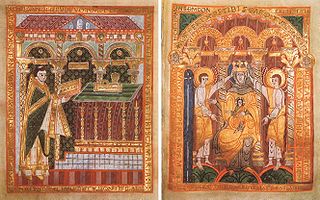
The Rich Bernward Gospels are a richly decorated evangeliary in the Hildesheim Cathedral Museum. It was a donation of Bernward, Bishop of Hildesheim, to his foundation St. Michael's, specifically for the altar to Mary in the crypt below the west choir, which was consecrated in 1015 and which he had designated as his tomb.
The Sainte-Chapelle Gospels or the Sainte-Chapelle Gospel Book is an Ottonian illuminated manuscript now housed in the Bibliothèque nationale de France in Paris as Latin 8851. It is made up of 156 parchment folios, in a 38.5 cm by 28 cm format, making it one of the largest manuscripts of its era. It includes miniatures such as the canon tables, Christ in majesty and the Four Evangelists. It is the work of the Master of the Registrum Gregorii, the most famous illuminator of the Ottonian Renaissance.
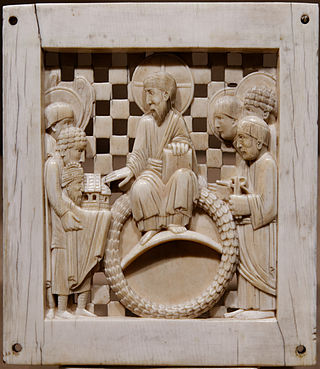
The Magdeburg Ivories are a set of 16 surviving ivory panels illustrating episodes of Christ's life. They were commissioned by Emperor Otto I, probably to mark the dedication of Magdeburg Cathedral, and the raising of the Magdeburg see to an archbishopric in 968. The panels were initially part of an unknown object in the cathedral that has been variously conjectured to be an antependium or altar front, a throne, door, pulpit, or an ambon; traditionally this conjectural object, and therefore the ivories as a group, has been called the Magdeburg Antependium. This object is believed to have been dismantled or destroyed in the 1000s, perhaps after a fire in 1049.
















